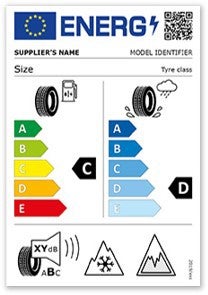# Know How
EU Tyre Label
The EU Tyre Label – What does it tell you?
Whilst the new EU tyre label regulation is not yet ratified into UK law, the tyre industry has committed to make new EU label values digitally available across the whole of the UK from 1st May. This ensures the availability of consistent consumer information for all tyres offered for sale across the UK, whether in Northern Ireland or GB.
All tyres sold in the European Union are subject to mandatory tyre labelling. A new EU tyre labelling scheme – effective since May 1, 2021 – provides more comprehensive information about selected tyres and also covers heavy-duty vehicle tyres. It provides objective, reliable and comparable information based on three important tyre performance characteristics: rolling resistance – and thus fuel efficiency, wet grip, and external rolling noise. Additional pictograms indicate the tyre's suitability for severe snow conditions (3PMSF symbol) and/or its grip in icy conditions, although the latter applies to passenger car tyres only.
The new labelling scheme covers passenger car, bus and truck tyres. For further details on the new EU tyre labelling regulation please visit the official EU Commission website.
Understanding the EU label and its pictograms helps drivers or fleet managers to make informed decisions about tyre-related road safety, lower CO₂ emissions, and greater fuel economy.
Please note that fuel savings and road safety are largely dependent on road and weather conditions, the vehicle type, and, in particular, the style of driving.
 New EU label effective from May 1, 2021
New EU label effective from May 1, 2021
How to read the EU Tyre Label
The tyre labelling features easy-to-understand pictograms that provide information on the following three essential aspects of a tyre’s performance.
1. Wet grip
Secure grip in wet conditions is crucial for safe driving. The wet grip rating indicates how well the tyre will perform in wet conditions, with performance graded from class A down to E. A high grade means short braking distances on wet roads.
2. Fuel efficiency
Depending on the tyre's rolling resistance, its fuel efficiency will range from class A (denoting the best fuel economy) all the way down to class E. Fuel consumption plays an important role from an economic and ecological point of view. This is because low fuel consumption has a positive effect on the carbon footprint of the vehicle, and of heavy-duty vehicles in particular.
3. Noise level
This is the external rolling noise generated by the tyre, measured in decibels. The label shows the noise level rated in classes from A down to C.
Additional pictograms for snow and icy conditions
In addition to the standard label, there are also pictograms − if applicable − relating to performance in severe snow conditions (3PMSF) and/or grip in icy conditions (passenger car/C1 tyres only).
The snow grip pictogram (3PMSF) will be shown for winter and all-season tyres tested under defined winter conditions and that deliver the required severe snow performance.
The ice grip pictogram will be shown for winter tyres with outstanding ice performance confirmed by a defined ice grip test. These tyres are specifically designed for road surfaces covered with ice and compact snow, and should only be used in very severe climate conditions (e.g. cold temperatures in the Nordics). Using ice grip tyres in less severe climate conditions (e.g. wet conditions or warmer winter temperatures) could result in suboptimal performance, in particular for wet grip, handling and wear.

How is rolling resistance linked to fuel efficiency?
As your tyres rotate, they also flex towards and away from the surface of the road, leading to a loss of energy. The amount of energy lost correlates with the rolling resistance of the tyre.
Tyres with low rolling resistance are the most energy efficient. That means it takes less power – and therefore less fuel – to move the vehicle.
Since tyres can account for between 20% and 30% of a vehicle’s fuel consumption, choosing new tyres that are energy efficient will result in direct fuel cost savings.
Tips for efficient driving
For improved fuel efficiency and greater road safety consider the following factors:
- Environmentally aware driving can reduce fuel consumption significantly
- Check your tyre pressures regularly; low pressure increases fuel consumption and affects braking performance
Always maintain a safe distance from the vehicle in front
- Check for signs of uneven wear on the tyres, especially along the edges of the front tyres. Uneven wear could indicate a tracking or suspension problem that could increase fuel consumption and cause your tyres to wear more quickly
- Avoid harsh acceleration and deceleration; this increases both fuel consumption and tyre wear
- Follow the vehicle manufacturer’s maintenance recommendations
- Extra weight increases fuel consumption; regularly clear out non-essential items from your car